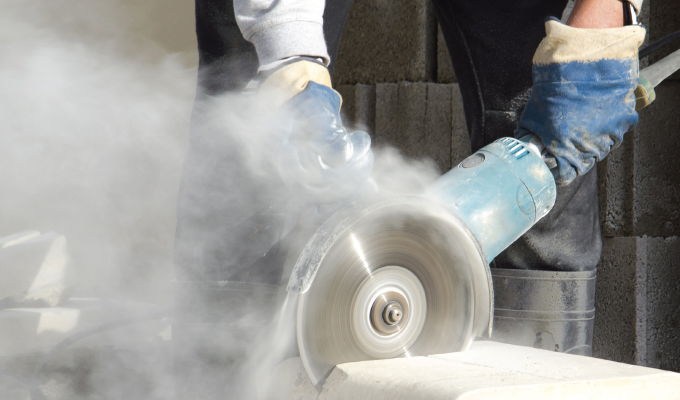In recent years, the Occupational Safety and Health Administration (OSHA) has promulgated regulations specific to the hazard of crystalline silica dust exposure. This issue raises very serious concerns for employers in the concrete industry or related trades.
Crystalline silica dust is a chemical compound which is commonly found in materials like sand, quartz, flint, or slate. While the most common and severe exposures to the compound typically occur in abrasive blasting operations to remove paint and rust, exposure during concrete operations is also a significant hazard. Crystalline silica can be disturbed and subject workers to exposure during such operations as concrete block or brick cutting or drilling, jack hammering, tuck pointing, or even concrete mixing.
Crystalline silica is typically not hazardous until exposed to the air, but when concrete is crushed, ground, or cut with a saw, crystalline silica can be and often is exposed to the air. Workers who inhale dust containing crystalline silica can develop significant health issues as a result; exposure to the compound has been linked to lung cancer, chronic obstructive pulmonary disease, and kidney disease. After exposure for 15 to 20 years, silicosis can result in scarring of the lungs which can make it difficult to take in oxygen. In severe cases, silicosis can be debilitating or sometimes fatal.
For this reason, in 2016, OSHA promulgated a rule setting forth standards for exposure to crystalline silica in the workplace which should be monitored carefully in any concrete project. The standard (29 CFR 1926.1153) requires employers to limit exposure to crystalline silica and to take other steps to protect workers.
ENGINEERING CONTROLS
As with most such standards, OSHA initially recommends engineering controls to avoid exposure of workers to the hazardous substance. Engineering controls involve changes to the manner in which work is done so that the hazard will be less likely to impact a worker. An example of an engineering control that might be used to limit crystalline silica exposure would be using a saw equipped with an integrated delivery system that continually feeds water to the blade, limiting dust, and otherwise operating and maintaining the tool in accordance with the manufacturer’s instructions to minimize dust emissions. An integrated ventilation hood system attached to a vacuum would be another example of an engineering control designed to reduce exposure to silica dust. These engineering controls can limit the extent to which other preventive measures need to be complied with in order to reach the OSHA standards.
RESPIRATORY PROTECTION
Along with engineering controls, the OSHA standards require respiratory protection if workers are exposed to the dust within a certain number of hours per shift, and depending on whether workers are working inside or outside. The regulation provides detailed tables as to the degree to which respiratory protection needs to be provided in connection with the variety of engineering controls that might be implemented. In addition, an appropriate occupational exposure review should be completed, often by an industrial hygienist, to determine the appropriate respirator to be utilized in a given application.
OTHER REQUIREMENTS
Regardless of the engineering or exposure control methods utilized, though, the OSHA standard requires all construction employers covered by the standard to do the following:
- Written exposure control plan: A written exposure control plan needs to be developed and implemented that not only identifies the tasks that might involve exposure and the extent of potential exposure, but also sets forth the methods and procedures used to protect workers from crystalline silica and other harmful substances connected to those practices.
- Competent person: A competent person needs to be designated who will be charged with implementing the written control plan—this individual will need to be familiar enough with the applicable regulations and work involved to be able to monitor and enforce compliance with the plan.
- Medical checks: The standard also sets forth the time and exposure criteria that require employers to provide certain medical checks, including chest x-rays.
- Record keeping: Employers are required to maintain detailed records not only of time and extent of exposure, but also of medical checks and reports.
CONCLUSION
Crystalline silica can be a significant safety and health issue in the concrete industry, and it is therefore critical for employers to familiarize themselves with OSHA’s very specific guidelines addressing exposure of workers to this hazard or consult with professionals who can assist them on these issues. Too often, written safety guidelines and exposure to control plans are prepared, but not fully implemented. Careful drafting of safety programs must be complemented by a careful program of continued monitoring of compliance with any requirements set forth, as well as faithful record-keeping during the pendency of the project. Of course, the primary goal of these programs is worker safety, but employers who fail to comply are also faced with significant potential liability, both to OSHA and the worker, that must be avoided.
About the author:
Thomas More Buckley is a partner in the Raleigh, North Carolina, office of Goldberg Segalla (www.goldbergsegalla.com). He represents businesses in complex commercial litigation matters involving construction, product liability, business dissolution, real estate disputes, partnership disputes, unfair trade practice claims, and many types of contractual disputes. He is chair of the Construction Law and Litigation Committee of the International Association of Defense Counsel. Buckley can be reached at tbuckley@goldbergsegalla.com.
Modern Contractor Solutions, January 2019
Did you enjoy this article?
Subscribe to the FREE Digital Edition of Modern Contractor Solutions magazine.



